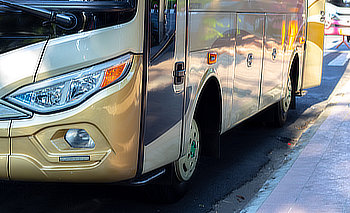Self-Driving Bus Service: Redefining Urban Transit
Las Vegas, Nevada
Self-driving bus transportation

Nevada, known for its pioneering spirit, has emerged as a leading hub for developing and deploying self-driving vehicles, and autonomous buses are one of them.
What is a self-driving public bus?
A self-driving bus is a public vehicle equipped with autonomous driving technology, allowing it to operate without human intervention. These buses use a combination of sensors, cameras, radar, lidar, GPS, and advanced software to navigate the road, detect obstacles, make decisions, and drive safely.
How self-driving buses work
Sensors: Self-driving bus is equipped with various sensors to perceive their environment. These sensors include cameras, which capture images and videos of the surroundings; radar, which detects objects and their distance; lidar, which uses laser beams to create detailed 3D maps; and GPS for location tracking.
Data processing: The data collected by the sensors is processed in real-time by onboard computers. Advanced algorithms analyze this data to identify objects, pedestrians, vehicles, and road signs, allowing the bus to make informed decisions.
Decision-making: Based on the information gathered and processed, the self-driving bus's software decides how to navigate the road, including when to accelerate, brake, change lanes, and turn.
Communication: Self-driving buses can communicate with other vehicles on the road, infrastructure, and even with a central control system to enhance safety and efficiency.
Redundancy and safety features: Self-driving bus is designed with redundant systems and safety features to mitigate the risk of accidents. For example, they have backup sensors, emergency braking systems, and fail-safe mechanisms to handle unexpected situations.
Where self-driving buses operate
Self-driving buses typically operate in controlled environments or on predetermined routes, such as university campuses, business parks, airports, and certain urban areas.
Here is a perfect example: San Francisco has launched an autonomous shuttle service in less than a week after California regulators approved the expansion of robotaxis. A free shuttle bus will run daily in a fixed route called the Loop around Treasure Island in the middle of San Francisco Bay. The Loop makes seven stops, connecting residential neighborhoods with stores and community centers. About 2,000 people live on the island.
Self-driving bus pilot programs in Las Vegas
• In Las Vegas, 2017-2018, AAA, Keolis, and RTC ran a successful self-driving minibus pilot program with Navya vehicles.
• Currently, in Las Vegas, the self-driving bus service operates on and off in downtown Las Vegas on Fremont Street and Container Park areas.
• The Zoox (Amazon subsidiary), which looks like a mini shuttle bus, has been driving on Las Vegas public roads and learning about the local driving environment since June 16, 2023.
Who makes self-driving buses?
Several manufacturers make self-driving buses. On top of the list are AV Volvo, Continental AG, Volkswagen AG, Tesla, Scania AB, Daimler AG, Proterra, Hyundai Motor Company, Hino Motors Ltd., and Navya.
Ownership of self-driving bus services
As for ownership, self-driving buses can be owned and operated by public transportation authorities, private companies, or partnerships between the two, as it happens in many Las Vegas pilot projects involving driverless services.
Liability in case of an accident
Nevada doesn't have special laws for self-driving vehicles, so the current negligence rules apply in case of an accident.
It means the at-fault party (or their business insurance) is financially liable for all damages. It includes medical bills, loss of wages, property damages, and pain and suffering.
In the case of self-driving bus services, the bus owner or service operator could be liable.
If you got injured in a self-driving shuttle bus accident in Las Vegas or Nevada, call us at 702-432-1000 to discuss your case.
Lawsuit challenges/issues
Challenges attorneys may face when representing people injured in an accident involving a self-driving bus include:
Determining liability: Establishing who is legally responsible for the self-driving bus accident can be challenging, especially when multiple parties could be involved.
Complex technology: Understanding the intricate technology behind self-driving buses and proving software or hardware malfunctions can be difficult.
Evolving laws and regulations: The legal landscape for autonomous vehicles continually evolves, making navigating and applying existing laws challenging.
Data access: Obtaining data from the autonomous system and other sources to support the case may require cooperation from manufacturers and operators.
Expert witnesses: The need for experts in autonomous vehicle technology and accident reconstruction may be critical for building a case.
Public perception: Public opinion about self-driving technology can impact the outcome of a case, making jury selection and persuasion more challenging.
Representing clients in self-driving bus accidents requires a deep understanding of traditional personal injury law, autonomous vehicles' unique challenges, and their complex technology.
When multiple parties are involved
Nevada law allows you to file a lawsuit against some or all defendants responsible for the accident. Also, if multiple victims were involved, under Nevada law, all victims who filed a claim must be compensated for damages. The same rules apply if you get into an accident involving a self-driving bus service.
If you were partially at fault
Nevada uses the rule of modified comparative negligence. It means the plaintiff can collect compensation from all other at-fault parties if the plaintiff was less than 51% responsible for the accident. The same is true about self-driving bus accidents.
Final thoughts
We plan to follow the laws surrounding self-driving bus services in Las Vegas or Nevada very closely and update this article with new information as soon as it becomes available.
Stay tuned!
Last updated on January 2, 2025.

